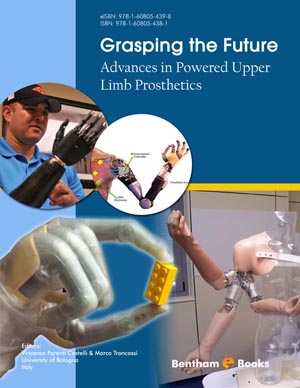Abstract
Recent findings in clinical neurophysiology show that the cortical representation of an amputated hand is not so largely affected, as once thought, by critical rearrangements, and that central and peripheral neural connections somehow maintain their functions. These findings paved the way towards the exploitation of cortical and peripheral residual functions by neural interfaces for hand prosthesis control. In the present study, a young male amputee has been implanted with four intraneural multielectrodes, two in the median and two in the ulnar stump nerves. During the next four weeks, these electrodes were used with the double purpose of recording neural signals (for the extraction of subject’s motor intentions to be performed by the robotic hand prosthesis) and eliciting sensory feedback through proper electrical stimulation (pulses frequency and duty cycle). Recorded neural signals were mapped in real-time onto three actions of the robotic hand through an amplitude on the best matching channel threshold method, while, thanks to an AI classifier trained offline, was achieved an 85% accuracy. Recorded peripheral nerves activity was then compared with the cortical activity over the missing hand motor area. By performing the classification of the motor intention over the peripheral signals solely during a time window compatible with the transmission delay of the motor command from the cortex, identified as an event related desynchronization of the EEG rhythm, the classification rate approached 100% of success. The study also aimed at investigating possible neurorehabilitative effects of the re-acquired stream of data to/from the missing limb and the continuative use of a high-interactive hand prosthesis. Results show that training for robotic hand control and for sensory perception produced a normalization in the electroencephalographic activation pattern and a reorganization of the motor cortical maps as evaluated via TMS, with restriction of the cortical overrepresentation of muscles proximal to the stump. In parallel, a clinical improvement of phantom limb pain has been observed, that recognizes in the correction of the aberrant plasticity in its anatomical substrate.
Keywords: Robotic Hand Electrodes, Multi-channel Interfaces, Proprioceptive and Tactile Feedback, Clinical Neurophysiology, Brain Plasticity, Phantom Limb Pain.






















